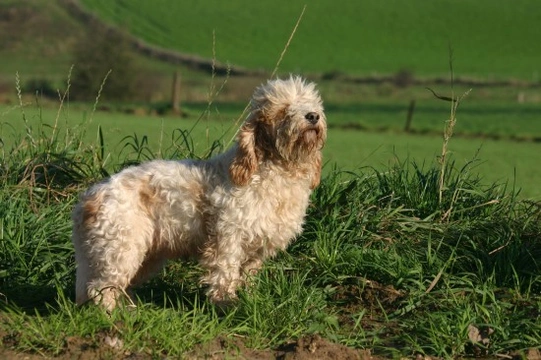
Petit Basset Griffon Vendeen hereditary health and wellness
The Petit Basset Griffon Vendeen (PBGV) is a small, cute-looking French dog, which belongs to the scent hound grouping. They are the smallest of the four Griffon Vendeen breeds, standing up to 15.5” tall at the withers, and weighing up to 20kg. Males and females of the breed tend to be similar in size, and the main difference at a glance between the sexes is the slightly higher dome of the skull present in dogs as opposed to bitches.
The PBGV has a rough, tousled coat that is harsh to the touch, and has a thick undercoat to provide warmth. The facial fur boasts a full beard and moustache, and the breed is also notable for having very long eyelashes! The coat has a white base, and may have a variety of accent colours on it, including grizzle, orange, lemon or black, as well as sable and tan. A wide range of colour combinations are possible within the breed, including bicolour and tricolour.
The build of the Petit Basset Griffon Vendeen is short legged, and longer than tall, with a long spine, although not as long comparatively as that of the Basset hound or the Dachshund. Due to their conformation, the breed can be prone to some health issues of the spine and back, as well as a range of other hereditary health issues within the breed’s gene pool as a whole.
In this article, we will look at the hereditary health, longevity and conformation of the Petit Basset Griffon Vendeen in more detail. Read on to learn more.
Basic care and lifestyle requirements of the Petit Basset Griffon Vendeen
The PBGV is a relatively low maintenance dog in terms of their day to day specialist care requirements, with an easy-care coat that does not require a lot of attention, and just the occasional comb out or bath required when the dog gets into a mess. They are active, alert and lively dogs that need to receive plenty of exercise, and require an active, fit owner that is prepared to dedicate plenty of time to walking the dog and keeping them entertained.
Petit Basset Griffon Vendeen average longevity
The average longevity of the breed as a whole within the UK is 12.1 years, with the longest recorded lifespan among surveyed owners of the breed being 17.3 years. The PBGV is classed as having a slightly longer than average life expectancy compared to other pedigree dogs of a similar size.
The main recorded causes of death among the surveyed dogs were listed as cancer at 33%, and old age at 24%. The most frequently occurring nonfatal health issues reported across the breed are skin sensitivities and a propensity to contracting mites, and issues with the ears such as infections and excessive wax build up.
Genetic diversity and conformation concerns across the breed
The coefficient of inbreeding statistic across the breed as a whole is recorded as 13%, which indicates that a reasonable amount of inbreeding is still present within the breed’s gene pool as a whole. Potential breeders and buyers of dogs of the breed are recommended to seek dogs with a lower than average coefficient of inbreeding figure in order to ensure genetic health and diversity within their dogs.
The British Veterinary Association runs a health scheme to test for persistent pupillary membrane, which is a hereditary eye condition. Potential parent dogs of the breed should also ideally be DNA tested for a propensity to primary open angle glaucoma, in order to try to reduce the incidence rate of this condition within the breed.
Due to the conformation of the Petit Basset Griffon Vendeen, which includes their short legs and long spines, the breed is considered to have an elevated risk of spinal problems, accompanied by the challenges of chondrodysplasia, which refers to the curved and abnormally short leg bones of the breed.
Hereditary health conditions within the Petit Basset Griffon Vendeen gene pool
As well as the conditions and potential problems mentioned above, there are a few other conditions that are recognised as having a hereditary element to them, but for which no current tests exist to confirm or rule out their presence prior to breeding. These conditions include:
- Epilepsy, a seizure disorder that can be either fairly minor or quite serious, and which is a lifelong condition that cannot be cured. While affected dogs should not be used for breeding, the condition can usually be successfully managed on an ongoing basis by means of medication.
- Hypothyroidism, which is an underproduction of the necessary thyroid hormones that are essential to maintaining a healthy weight and hormonal balance. The condition again cannot be cured or prevented, but supplementary hormone medication can make the condition more manageable.
- Muscular dystrophy, which leads to muscular pain, weakness and problems with normal movement, is also known to be present within the Petit Basset Griffon Vendeen gene pool.



